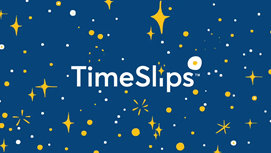Sounds, Snow, and Superheroes: How Creative Engagement Can Look
 Hot chocolate. Rain against my window. Coffee in the morning. My puppy on a sunny day. These were all chat and verbal responses to the TimeSlips beautiful question “What relaxes you?” posed by one of our Dementia Inclusive Durham (DID) site lead meeting attendees. Twenty five of us had come together from various organisms (DID, TimeSlips, and Duke University) and physical locations to discuss site updates and plans for centralized DID organization moving forward. As we went around the virtual Zoom room, I learned from participants the intricacies involved in running and leading sites and client schedules, and the many moving parts to implementing the TimeSlips creative care method with both volunteers and elders. I shared my updates on the master calendar and student team database I was designing and reminded attendees of the Friday afternoon creative care gatherings happening through Professor Sarah Wilbur’s half-credit Interdisciplinary Arts class.
Hot chocolate. Rain against my window. Coffee in the morning. My puppy on a sunny day. These were all chat and verbal responses to the TimeSlips beautiful question “What relaxes you?” posed by one of our Dementia Inclusive Durham (DID) site lead meeting attendees. Twenty five of us had come together from various organisms (DID, TimeSlips, and Duke University) and physical locations to discuss site updates and plans for centralized DID organization moving forward. As we went around the virtual Zoom room, I learned from participants the intricacies involved in running and leading sites and client schedules, and the many moving parts to implementing the TimeSlips creative care method with both volunteers and elders. I shared my updates on the master calendar and student team database I was designing and reminded attendees of the Friday afternoon creative care gatherings happening through Professor Sarah Wilbur’s half-credit Interdisciplinary Arts class.
Joined often by Kathy Hawkins of TimeSlips and Carmelita Karhoff of Dementia Inclusive Durham, Dr. Wilbur or an artist in residence at one of the sites took the students in our course through a story together – one afternoon about the sounds of the color blue, another about snow and winter, and another about superhero powers. Even across barriers of physical distance and differences in age between participants, I could feel the trust and joy grow in our space each session. The excitement felt by both returning and new volunteers was something I wanted to cultivate – through supporting them by organizing session logistics and client matches – so that they too could have the magical experiences I’ve had as a volunteer. While my work behind the scenes with Dementia Inclusive Durham has taught me some of the inner workings of NGO functioning and how to work with individuals holding different roles, my sessions with clients and other volunteers show me why we are doing this in the first place – to build relationships across barriers, show and embody the importance of living in the moment, and contribute to improving the health of and learning from vulnerable members of our community.
As students in Dr. Wilbur’s spring course look forward to their initial meetings and weekly sessions with their respective clients, I think back to my own first session a few months ago. What started with a few minutes discussing “What is the most beautiful sound in your home? The world?” turned into seven weeks of laughter, emotional conversations, and music-making with our respective instruments. I’ve learned, and want to emphasize to others, that communication with elders or individuals with disabilities does not have to focus on the past, memories, or physical ability – connections can be built across any kind of topic, as long as they are approached mindfully and with curiosity and compassion. I hope that volunteers experiencing and utilizing creative engagement can not only improve the measured quality of life of our elderly clients but show to them (many of whom are pre-medical and pursuing public health) the importance of empathy and imagination in their relationships with peers, elders, and future patients and collaborators.
Across Dementia Inclusive Durham’s seven sites, no one creative care session is the same. Some invite group sessions with elders and an artist, listening to music and journaling about experiences. Others are focused on one-on-one sessions between elders and student volunteers, working together to answer beautiful questions and build a story. Still others are still building infrastructure for their own work, attending our Friday afternoon practice sessions and learning from other site leads how they could participate in the TimeSlips method. It has been incredibly rewarding to truly see the diversity of how creative engagement can be applied, and assist both more rooted sites in gaining volunteers and newer sites in supporting and learning how they can join in the process. With my master calendar of sessions and database of student volunteers in tow, I am excited to continue acting as a magician behind the scenes during the rest of the semester – and look forward, at the end of this fellowship, to assisting with the continuation of this supporting role and seeing how creative engagement can be adapted to be continued over Zoom and hopefully applied in person as well.
